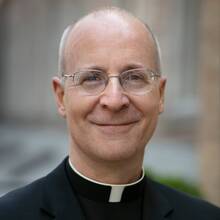 Normally I don't blog about articles in the Culture section in the print edition, but I want to draw your attention to an online slide show of the work of Jonathan Alpeyrie, a prominent photographer who, in December of 2009, visited the remote monastery of Kintsvisi in Georgia. We fit as many of his amazing photos as we could in the Culture section of the mag this week, and his description of his visit is here. But we have used the rest of them in a wonderful slide show that Tim Reidy, our online editor, created (along with one of my favorite CDs of chant from that part of the world.) The slide show, with captions, is here.
Normally I don't blog about articles in the Culture section in the print edition, but I want to draw your attention to an online slide show of the work of Jonathan Alpeyrie, a prominent photographer who, in December of 2009, visited the remote monastery of Kintsvisi in Georgia. We fit as many of his amazing photos as we could in the Culture section of the mag this week, and his description of his visit is here. But we have used the rest of them in a wonderful slide show that Tim Reidy, our online editor, created (along with one of my favorite CDs of chant from that part of the world.) The slide show, with captions, is here.








I forwarded this slideshow to a friend of mine whom I have occasionally tried to convince of the beauty of church music. She responded, "Well, yes, it's absolutely gorgeous. But that's not the kind of music I hear when I step inside a Catholic church." Sadly, I can't disagree with her. The Church is responsible for some of the greatest music ever composed; why have so few Catholics ever even heard of Josquin, Palestrina, Gabrieli? I know that it is hard to find great vocal and musical talent in just any American parish, so I don't want to sound as fussy as I may sound pretentious! But one doesn't have to be a sedevacantist to lament the aesthetic mediocrity of so many local liturgies.
I spent a year in Paris, France, and when friends would visit me, I'd always take them to the Sacre-Coeur basilica as the nuns were singing vespers. A Protestant uncle was so moved by its beauty that he determined to visit the local Catholic cathedral back home every Wednesday for prayer. Another relative, a defiant atheist, said she felt more at peace in that basilica than she had in a long time. A friend of mine whose feminism has left her angry at the Church had to leave the service in tears. We often treat beauty and transcendence as nice appendages of the liturgy, stressing instead their communal function and the immanent. But transcendence awakens hearts and activates our deepest spiritual intuitions, and if we can't find the transcendent in a church, where will we find it in this postmodern world? Every time the words of consecration are spoken rather than chanted, I feel as though a valuable opportunity has been lost.
Von Balthasar is prophetic: without beauty, "the good also loses its attractiveness, the self-evidence of why it must be carried out." And, "Our situation today shows that beauty demands for itself at least as much courage and decision as do truth and goodness. We can be sure that whoever sneers at her name as if she were the ornament of a bourgeois past - whether he admits it or not - can no longer pray, and soon will no longer be able to love...."